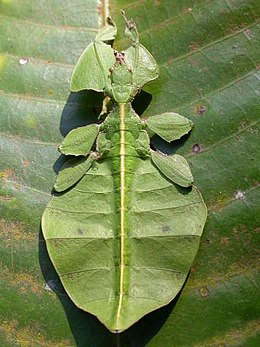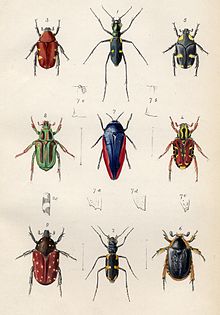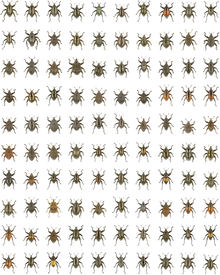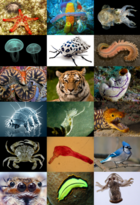
Entomology
Entomology (from Ancient Greek ἔντομον (entomon) 'insect', and -λογία (-logia) 'study of') is the scientific study of insects, a branch of zoology. In the past the term "insect" was less specific, and historically the definition of entomology would also include the study of animals in other arthropod groups, such as arachnids, myriapods, and crustaceans. This wider meaning may still be encountered in informal use.
Like several of the other fields that are categorized within zoology, entomology is a taxon-based category; any form of scientific study in which there is a focus on insect-related inquiries is, by definition, entomology. Entomology therefore overlaps with a cross-section of topics as diverse as molecular genetics, behavior, neuroscience, biomechanics, biochemistry, systematics, physiology, developmental biology, ecology, morphology, and paleontology.
Over 1.3 million insect species have been described, more than two-thirds of all known species. Some insect species date back to around 400 million years ago. They have many kinds of interactions with humans and other forms of life on Earth.
History
Entomology is rooted in nearly all human cultures from prehistoric times, primarily in the context of agriculture (especially biological control and beekeeping). The natural philosopher Pliny the Elder, (23 - 79 AD) wrote a book on the kinds of Insects, while the scientist of Kufa, Ibn al-A‘rābī (760 - 845 AD) wrote a book on flies, Kitāb al-Dabāb (كتاب الذباب). However scientific study in the modern sense began only relatively recently, in the 16th century.Ulisse Aldrovandi's De Animalibus Insectis (Of Insect Animals) was published in 1602. Microscopist Jan Swammerdam published History of Insects correctly describing the reproductive organs of insects and metamorphosis. In 1705, Maria Sibylla Merian published a book Metamorphosis Insectorum Surinamensium about the tropical insects of Dutch Surinam.
Early entomological works associated with the naming and classification of species followed the practice of maintaining cabinets of curiosity, predominantly in Europe. This collecting fashion led to the formation of natural history societies, exhibitions of private collections, and journals for recording communications and the documentation of new species. Many of the collectors tended to be from the aristocracy and it spawned off a trade involving collectors around the world and traders. This has been called the "era of heroic entomology." William Kirby is widely considered as the father of entomology in England. In collaboration with William Spence, he published a definitive entomological encyclopedia, Introduction to Entomology, regarded as the subject's foundational text. He also helped to found the Royal Entomological Society in London in 1833, one of the earliest such societies in the world; earlier antecedents, such as the Aurelian society date back to the 1740s. In the late 19th century, the growth of agriculture, and colonial trade, spawned off the "era of economic entomology" which created the professional entomologist associated with the rise of the university and training in the field of biology.
Entomology developed rapidly in the 19th and 20th centuries, and was studied by large numbers of people, including such notable figures as Charles Darwin, Jean-Henri Fabre, Vladimir Nabokov, Karl von Frisch (winner of the 1973 Nobel Prize in Physiology or Medicine), and two-time Pulitzer Prize winner E. O. Wilson.
There has also been a history of people becoming entomologists through museum curation and research assistance, such as Sophie Lutterlough at the Smithsonian National Museum of Natural History. Insect identification is an increasingly common hobby, with butterflies and dragonflies being the most popular.
Most insects can easily be recognized to order such as Hymenoptera (bees, wasps, and ants) or Coleoptera (beetles). However, identifying to genus or species is usually only possible through the use of identification keys and monographs. Because the class Insecta contains a very large number of species (over 330,000 species of beetles alone) and the characteristics separating them are unfamiliar, and often subtle (or invisible without a microscope), this is often very difficult even for a specialist. This has led to the development of automated species identification systems targeted on insects, for example, Daisy, ABIS, SPIDA and Draw-wing.
In pest control
In 1994, the Entomological Society of America launched a new professional certification program for the pest control industry called the Associate Certified Entomologist (ACE). To qualify as a "true entomologist" an individual would normally require an advanced degree, with most entomologists pursuing a PhD. While not true entomologists in the traditional sense, individuals who attain the ACE certification may be referred to as ACEs or Associate Certified Entomologists.
Subdisciplines
Many entomologists specialize in a single order or even a family of insects, and a number of these subspecialties are given their own informal names, typically (but not always) derived from the scientific name of the group:
- Coleopterology – beetles.
- Dipterology – flies.
- Odonatology – dragonflies and damselflies.
- Hemipterology – true bugs.
- Isopterology – termites.
- Lepidopterology – moths and butterflies.
- Melittology (or Apiology) – bees.
- Myrmecology – ants
- Orthopterology – grasshoppers, crickets, etc.
- Trichopterology – caddisflies.
- Vespology – Social wasps.
Entomologists
Organizations
Like other scientific specialties, entomologists have a number of local, national, and international organizations. There are also many organizations specializing in specific subareas.
- Amateur Entomologists' Society
- Entomological Society of America
- Entomological Society of Canada
- Entomological Society of Japan
- Entomologischer Verein Krefeld
- Entomological Society of India
- International Union for the Study of Social Insects
- Netherlands Entomological Society
- Royal Belgian Entomological Society
- Royal Entomological Society of London
- Russian Entomological Society
- Senckenberg Deutsches Entomologisches Institut
- Société entomologique de France
- Australian Entomological Society
- Entomological Society of New Zealand
Research collection
Here is a list of selected very large insect collections, housed in museums, universities, or research institutes.
Asia
- Zoological Survey of India
- Insect Museum, Tamil Nadu Agricultural University, Coimbatore, Tamil Nadu, India
- National Pusa Collection, Division of Entomology, Indian Agricultural Research Institute, New Delhi, India
- Pakistan Museum of Natural History Garden Avenue, Shakarparian, Islamabad, Pakistan
- Museum Zoologicum Bogoriense, Indonesia
Africa
- Natal Museum, Pietermaritzburg, South Africa
Australasia
- Lincoln University Entomology Research Collection, Lincoln, New Zealand
- Museum of New Zealand Te Papa Tongarewa, Wellington, New Zealand
- New Zealand Arthropod Collection, Landcare Research Manaaki Whenua, Auckland, New Zealand
Europe
- Bavarian State Collection of Zoology, Zoologische Staatssammlung München
- Museu de Ciències Naturals de Barcelona, Barcelona, Spain
- Muséum national d'histoire naturelle, Paris, France
- Museum für Naturkunde, Berlin, Germany
- Kelvingrove Art Gallery, Glasgow, Scotland
- Natural History Museum, Budapest Hungarian Natural History Museum
- Natural History Museum, Geneva
- Natural History Museum, Leiden, the Netherlands
- Natural History Museum, London, United Kingdom
- Natural History Museum, OsloNorway
- Natural History Museum, St. Petersburg Zoological Collection of the Russian Academy of Science
- Naturhistorisches Museum, Vienna, Austria
- Oxford University Museum of Natural History, Oxford
- Royal Museum for Central Africa, Brussels, Belgium
- Swedish Museum of Natural History, Stockholm, Sweden
- World Museum Liverpool, the Bug House
United States
- Academy of Natural Sciences of Philadelphia
- American Museum of Natural History, New York City
- Auburn University Museum of Natural History,Auburn, Alabama
- Audubon Insectarium, New Orleans
- Bohart Museum of Entomology, Davis, California
- California Academy of Sciences, San Francisco
- Carnegie Museum of Natural History,Pittsburgh
- Cleveland Museum of Natural History, Cleveland
- Entomology Research Museum, University of California, Riverside
- Essig Museum of Entomology, Berkeley, California
- Field Museum of Natural History, Chicago
- Florida Museum of Natural History, University of Florida, Gainesville, Florida
- Illinois Natural History Survey, Champaign, Illinois
- J. Gordon Edwards Museum, San Jose, California
- Museum of Comparative Zoology, Cambridge, Massachusetts
- Natural History Museum of Los Angeles County, Los Angeles
- National Museum of Natural History, Washington, D.C.
- New Mexico State University Arthropod Museum
- North Carolina State University Insect Museum, Raleigh, North Carolina
- Peabody Museum of Natural History, New Haven, Connecticut
- San Diego Natural History Museum, San Diego, California
- The National Museum of Play, Rochester, N.Y.
- Texas A&M University, College Station, Texas
- University of Minnesota, St. Paul campus (UMSP), Minnesota
- University of Kansas Natural History Museum, Lawrence, Kansas
- University of Nebraska State Museum, Lincoln, Nebraska
- University of Missouri Enns Entomology Museum,University of Missouri, Columbia, Missouri
Canada
- Canadian Museum of Nature, Ottawa, Ontario
- Canadian National Collection of Insects, Arachnids and Nematodes,Ottawa, Ontario
- E.H. Strickland Entomological Museum,University of Alberta, Edmonton, Alberta
- Lyman Entomological Museum,Macdonald Campus of McGill University, Sainte-Anne-de-Bellevue, Quebec
- Montreal Insectarium, Montreal, Quebec
- Newfoundland Insectarium, Reidville, Newfoundland and Labrador
- Royal Alberta Museum, Edmonton, Alberta
- Royal Ontario Museum, Toronto, Ontario
- University of Guelph Insect Collection,Guelph, Ontario
- Victoria Bug Zoo,Victoria, British Columbia
- J. B. Wallis / R. E. Roughley Museum of Entomology, Winnipeg, Manitoba
See also
- Arachnology
- Carcinology
- Cultural entomology
- Ethnoentomology
- Forensic entomology
- Forensic entomologist
- Forensic entomology and the law
- Insect thermoregulation
- Insects on stamps
- List of entomological journals
- Medical entomology
- Myriapodology
- Timeline of entomology – 1800–1850
- Timeline of entomology – 1850–1900
- Timeline of entomology since 1900
Further reading
"I suppose you are an entomologist?"
"Not quite so ambitious as that, sir. I should like to put my eyes on the individual entitled to that name. No man can be truly called an entomologist, sir; the subject is too vast for any single human intelligence to grasp."
Oliver Wendell Holmes, Sr., The Poet at the Breakfast Table
- Chiang, H.C. and G. C. Jahn 1996. Entomology in the Cambodia-IRRI-Australia Project. (in Chinese) Chinese Entomol. Soc. Newsltr. (Taiwan) 3: 9–11.
- Davidson, E. 2006. Big Fleas Have Little Fleas: How Discoveries of Invertebrate Diseases Are Advancing Modern Science University of Arizona Press, Tucson, 208 pages, ISBN 0-8165-2544-7.
- Cedric Gillot: Entomology. Second Edition, Plenum Press, New York, NY / London 1995, ISBN 0-306-44967-6.
- Triplehorn, Charles A. and Norman F. Johnson (2005-05-19). Borror and DeLong's Introduction to the Study of Insects, 7th edition, Thomas Brooks/Cole. ISBN 0-03-096835-6. — a classic textbook in North America.
-
Grimaldi, D. & Engel, M.S. (2005). Evolution of the Insects. Cambridge University Press. ISBN 0-521-82149-5.
{{cite book}}: CS1 maint: multiple names: authors list (link) - Capinera, JL (editor). 2008. Encyclopedia of Entomology, 2nd Edition. Springer. ISBN 1-4020-6242-7
External links
| |||||||||||||||||||||||||||||||||||||||||||||||||||||||||||||||
| |||||||||||||||||||||||||||||||||||||||||||||||||||||||||||||||
| |||||||||||||||||
| |||||||||||||||||
| Branches |
|
||||
|---|---|---|---|---|---|
| Animal groups | |||||
|
Animal anatomy Animal morphology |
|
||||
| Animal physiology |
|
||||
| Zoologists | |||||
| History | |||||







